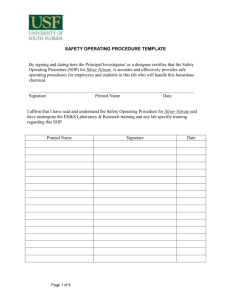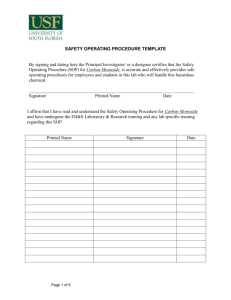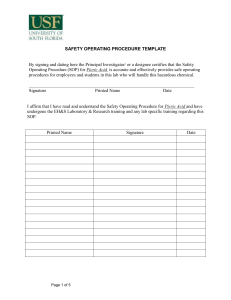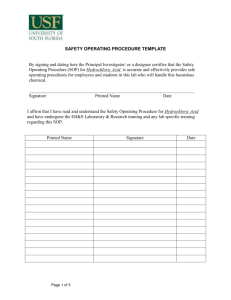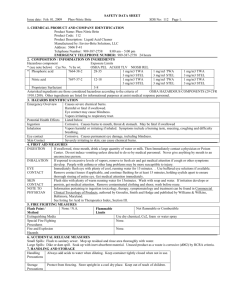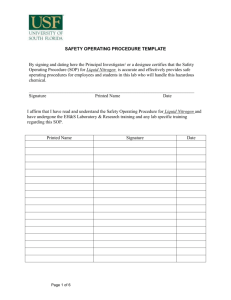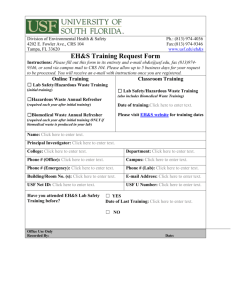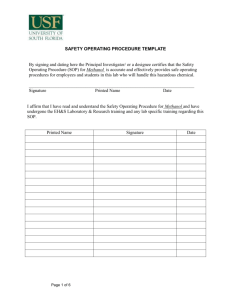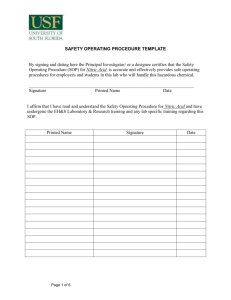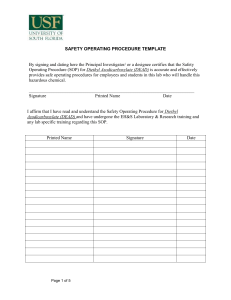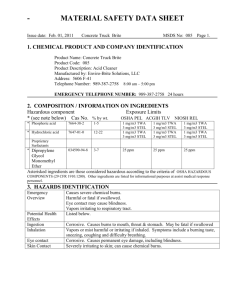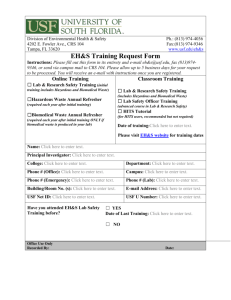SOP template & guidance - University of South Florida
advertisement
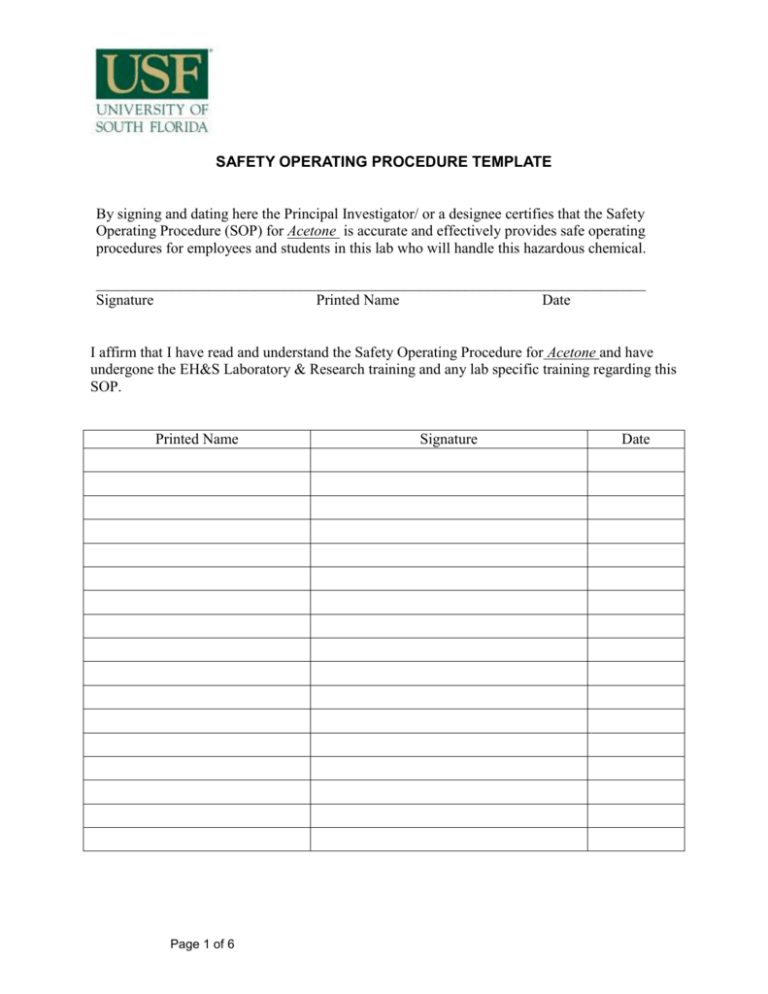
SAFETY OPERATING PROCEDURE TEMPLATE By signing and dating here the Principal Investigator/ or a designee certifies that the Safety Operating Procedure (SOP) for Acetone is accurate and effectively provides safe operating procedures for employees and students in this lab who will handle this hazardous chemical. _________________________________________________________________________ Signature Printed Name Date I affirm that I have read and understand the Safety Operating Procedure for Acetone and have undergone the EH&S Laboratory & Research training and any lab specific training regarding this SOP. Printed Name Page 1 of 6 Signature Date CONTACT INFORMATION: Chemical Name: Acetone 67-64-1 Building/Room Number: Date of Creation/Revision 8/2/2012 Principal Investigator: Emergency Phone number: HAZARD SUMMARY Potential physical and health hazards associated with the use of this chemical include: Potential Acute Health Effects: Hazardous in case of skin contact (irritant), of eye contact (irritant), of ingestion, of inhalation. Slightly hazardous in case of skin contact (permeator). Potential Chronic Health Effects: CARCINOGENIC EFFECTS: A4 (Not classifiable for human or animal.) by ACGIH. MUTAGENIC EFFECTS: Not available. TERATOGENIC EFFECTS: Not available. DEVELOPMENTAL TOXICITY: Classified Reproductive system/toxin/female, Reproductive system/toxin/male [SUSPECTED]. The substance is toxic to central nervous system (CNS). The substance may be toxic to kidneys, the reproductive system, liver, skin. Repeated or prolonged exposure to the substance can produce target organs damage. Eye Contact: Check for and remove any contact lenses. Immediately flush eyes with running water for at least 15 minutes, keeping eyelids open. Cold water may be used. Get medical attention. Skin Contact: In case of contact, immediately flush skin with plenty of water. Cover the irritated skin with an emollient. Remove contaminated clothing and shoes. Cold water may be used.Wash clothing before reuse. Thoroughly clean shoes before reuse. Get medical attention. Serious Skin Contact: Wash with a disinfectant soap and cover the contaminated skin with an antibacterial cream. Seek medical attention. Inhalation: If inhaled, remove to fresh air. If not breathing, give artificial respiration. If breathing is difficult, give oxygen. Get medical attention if symptoms appear. Serious Inhalation: Evacuate the victim to a safe area as soon as possible. Loosen tight clothing such as a collar, tie, belt or waistband. If breathing is difficult, administer oxygen. If the victim is not breathing, perform mouth-to-mouth resuscitation. Seek medical attention Page 2 of 6 Ingestion: Do NOT induce vomiting unless directed to do so by medical personnel. Never give anything by mouth to an unconscious person. Loosen tight clothing such as a collar, tie, belt or waistband. Get medical attention if symptoms appear. Serious Ingestion: Not available SPECIAL HANDLING AND STORAGE REQUIREMENTS Describe special handling and storage requirements for this hazardous chemical in your laboratory, i.e. restricted access to chemical, inclusion of designated areas to limit and minimize possible sources of exposure to these materials. The entire laboratory, a portion of the laboratory, or a laboratory fume hood or bench may be considered a designated area. Special handling and storage requirements for this chemical include: Precautions: Keep locked up. Keep away from heat. Keep away from sources of ignition. Ground all equipment containing material. Do not ingest. Do not breathe gas/fumes/ vapor/spray. Wear suitable protective clothing. In case of insufficient ventilation, wear suitable respiratory equipment. If ingested, seek medical advice immediately and show the container or the label. Avoid contact with skin and eyes. Keep away from incompatibles such as oxidizing agents, reducing agents, acids, alkalis. Storage: Store in a segregated and approved area (flammables area) . Keep container in a cool, well-ventilated area. Keep container tightly closed and sealed until ready for use. Keep away from direct sunlight and heat and avoid all possible sources of ignition (spark or flame). ENGINEERING AND VENTILATION CONTROLS Include requirements for specific engineering/ventilation controls for this specific chemical, i.e. fume hood. If the process does not permit the handling of such materials in a fume hood, the lab personnel should contact Environmental Health and Safety at x4-4036 for review the adequacy of ventilation measures. Handling processes should be designed to minimize the potential for splash, splatter, or other likely scenarios for accidental contact. The handling of this chemical must be conducted in a fume hood. Additional engineering/ventilation controls for the handling of this chemical include: Provide exhaust ventilation or other engineering controls to keep the airborne concentrations of vapors below their respective threshold limit value. Ensure that eyewash stations and safety showers are proximal to the work-station location. PERSONAL PROTECTIVE EQUIPMENT Include specific personal protective equipment required for the handling of this chemical. See the following references: 1. The USF Hazardous Inventory Tracking System (HITS) provides access to MSDS. Page 3 of 6 2. A glove compatibility chart provides specific information on the type of safety gloves that should be used based on the hazards of specific chemicals. 3. The following EH&S webpage provides links to glove manufacturers as well as other PPE selection resources, http://usfweb2.usf.edu/eh&s/labsafety/links.html. At minimum, safety glasses, lab coat, and gloves are to be worn when using this hazardous chemical. Additional PPE Requirements for the handling of this chemical include: appropriate clothing (long pants, close-toed shoes) gloves; indicate type:______________________________ safety goggles □ face shield □ flame-resistant lab coats □ other:__________________________ If the use of an N95, half mask, or full face respirator is requested, the individual and/or their supervisor must first contact Environmental Health & Safety for a consultation to determine if respirator use is necessary. If EH&S determines the use of a respirator is necessary, the individual must participate in the University’s respirator program. This includes a medical evaluation; respirator fit test, and training. Personal Protection in Case of a Large Spill: Splash goggles. Full suit. Vapor respirator. Boots. Gloves. A self contained breathing apparatus should be used to avoid inhalation of the product. Suggested protective clothing might not be sufficient; consult a specialist BEFORE handling this product. Exposure Limits: TWA: 500 STEL: 750 (ppm) from ACGIH (TLV) [United States] TWA: 750 STEL: 1000 (ppm) from OSHA (PEL) [United States] TWA: 500 STEL: 1000 [Austalia] TWA: 1185 STEL: 2375 (mg/m3) [Australia] TWA: 750 STEL: 1500 (ppm) [United Kingdom (UK)] TWA: 1810 STEL: 3620 (mg/m3) [United Kingdom (UK)] TWA: 1800 STEL: 2400 from OSHA (PEL) [United States]Consult local authorities for acceptable exposure limits. EMERGENCY PROCEDURES If a there is a spill involving an extremely hazardous chemical, emergency responders should be contacted immediately. Dial 911 during and after normal business hours to contact the local emergency responders for your area and provide detail information to the emergency responders including chemical name, volume, hazards, spill location, and any injuries incurred. Building occupants can be notified of a building evacuation through the activation of a fire alarm pull station. Personnel: If lab personnel are exposed to an extremely hazardous chemical, call 911 immediately. Remove any contaminated clothing, and IMMEDIATELY flush contaminated skin with water for at least 15 minutes following any skin contact. For eye exposures, IMMEDIATELY flush eyes with water for at least 15 minutes. Consult MSDS for guidance on appropriate first aid. Where medical attention is required, ensure to bring along MSDS(s) of chemical(s) to aid medical staff in proper diagnosis and treatment. Fire and Emergency Evacuation Procedures: In case of fire or emergency situation, call 911 and or use emergency blue phone immediately to notify Page 4 of 6 the fire emergency services and campus police. Immediately evacuate the building via the nearest exit when the fire alarm is activated. If unable to evacuate due to a disability, shelter in the area of rescue / refuge, typically a stairwell landing, and wait for assistance from drill volunteers or emergency responders. Instruct visitors and students to evacuate and assist them in locating the nearest exit. Do not use elevators to exit the building during an evacuation as they may become inoperable. Carry only those personal belongings that are within the immediate vicinity. Close doors to limit the potential spread of smoke and fire. Terminate all hazardous operations and power off equipment. Close all hazardous materials containers. Remain outside of the building until the building is released for reentry. Do not restrict or impede the evacuation. Convene in the designated grassy gathering area and await instruction from emergency responders or drill volunteers. Avoid parking lots. Report fire alarm deficiencies, (e.g., trouble hearing the alarm) to facilities personnel for repair. Notify evacuation drill volunteers or emergency responders of persons sheltering in the areas of rescue/ refuge. Never assume that an alarm is a “false alarm”. Treat all fire alarm activations as emergencies. Get out of the building! General Information: Use proper personal protective equipment as indicated above. Spills/Leaks: Use water spray to disperse the gas/vapor. Remove all sources of ignition. Absorb spill using an absorbent, non-combustible material such as earth, sand, or vermiculite. Do not use combustible materials such as sawdust. Use a spark-proof tool. Provide ventilation. A vapor suppressing foam may be used to reduce vapors. Water spray may reduce vapor but may not prevent ignition in closed spaces. The Laboratory/Studio and Field Incident Report form is to be completed by the Lab Manager/Teaching Assistant/Instructor for any incident that occurs in any University of South Florida affiliated teaching or research laboratory/studio or field research project. An incident means any unplanned event within the scope of a procedure that causes, or has the potential to cause, an injury or illness and/or damage to equipment, buildings, or the natural environment. Please fill out the online Laboratory/Studio and Field Incident Report form below and submit to Environmental Health & Safety within 24 hours of the incident. Due to medical privacy concerns, no personal identifying information of the person involved in the incident shall be entered or submitted with the form. http://usfweb2.usf.edu/eh&s/labsafety/LabIncident.html WASTE DISPOSAL All chemical waste generated within USF System laboratories are considered hazardous waste and must be disposed of as hazardous waste in accordance with USF Hazardous Waste Management Procedure, the EPA, and the DEP. The USF Hazardous Waste Management Procedure can be found using the following link, http://compass.custhelp.com/app/answers/detail/a_id/1118/kw/hazardous%20waste. TRAINING REQUIREMENTS All individuals working with chemicals in USF laboratories must take EH&S’s Laboratory & Research Safety Training. To register for Laboratory & Research Training, please use the following link, http://usfweb2.usf.edu/eh&s/labsafety/tmaterials.html. However, the use of this chemical may warrant additional safety training per the PI, EH&S, or an authorizing unit such as the Biosafety or Radiation Safety programs. Additional training requirements are listed below. Page 5 of 6 Training Requirements: Laboratory & Research Safety Training (EH&S) Research-specific Training (PI) □ Other _____________________________________________________________ PRIOR APPROVALS □ The handling of this chemical requires prior approval from the PI/designee. The handling of this chemical does not require prior approval from the PI/designee. Approval Signature (if required by PI) _________________________________________________________ Page 6 of 6
